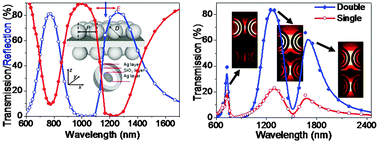Robust multispectral transparency in continuous metal film structures via multiple near-field plasmon coupling by a finite-difference time-domain method
Abstract
We propose a robust multispectral transparent plasmonic structure and calculate its transparency response by using the three-dimensional finite-difference time-domain (FDTD) method. The proposed structure is composed of a continuous ultrathin metal film sandwiched by double two-dimensional (2D) hexagonal non-close-packed metal–dielectric multilayer core–shell nanoparticle arrays. The top and bottom plasmonic arrays in such a structure, respectively, act as the light input and output couplers to carry out the efficient trapping and release of light. Near-perfect multispectral optical transparency in the visible and near-infrared regions is achieved theoretically. The calculated electric field distribution patterns show that the near-perfect multispectral optical transparency mainly originates from the excitation and hybridization of shell and core plasmon modes, strong near-field coupling of dipole plasmon modes between adjacent nanoparticles as well as the excitation of surface plasmon waves of the metal film. The robust transparency bands can be efficiently tuned in a large range by varying the structural parameters and the surrounding dielectric environment. The proposed structure also shows additional merits such as a deep sub-wavelength size and fully retained electrical and mechanical properties of the natural metal. These features might provide promising applications in highly integrated optoelectronic devices including plasmonic filters, nanoscale multiplexers, and non-linear optics.


 Please wait while we load your content...
Please wait while we load your content...